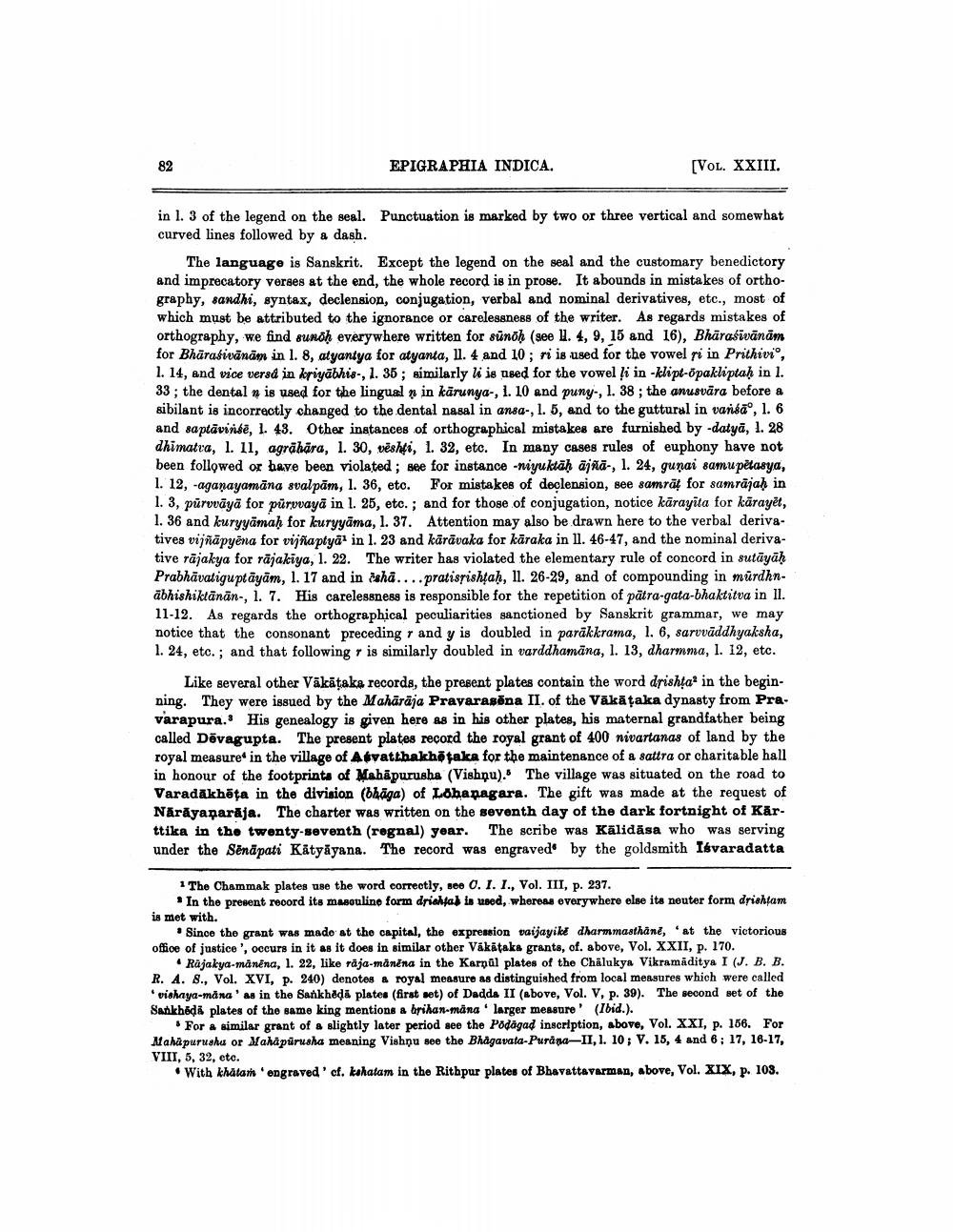________________
EPIGRAPHIA INDICA.
[VOL. XXIII.
in l. 3 of the legend on the seal. Punctuation is marked by two or three vertical and somewhat curved lines followed by a dash.
The language is Sanskrit. Except the legend on the seal and the customary benedictory and imprecatory verses at the end, the whole record is in prose. It abounds in mistakes of orthography, sandhi, syntax, declension, conjugation, verbal and nominal derivatives, etc., most of which must be attributed to the ignorance or carelessness of the writer. As regards mistakes of orthography, we find sunoh everywhere written for sūnoh (see 11. 4, 9, 15 and 16), Bhäraśivānām for Bhārasivānām in l. 8, atyantya for atyanta, 11. 4 and 10; ri is used for the vowel si in Prithivi, 1. 14, and vice versd in kriyābhis., 1.35; similarly li is used for the vowel si in-klipe-Opakliptah in l. 33; the dental n is used for the lingual n in kārunya-, l. 10 and puny, 1.38; the anusvāra before a sibilant is incorrectly changed to the dental nasal in ansa-, 1. 5, and to the guttural in varisão, 1. 6 and saptāvirise, l. 43. Other instances of orthographical mistakes are furnished by -dalyā, 1. 28 dhimatra, l. 11, agrāhāra, 1. 30, vështi, 1. 32, etc. In many cases rules of euphony have not been followed or have been violated; see for instance - niyuktāḥ ajñā-, 1. 24, gunai samupetasya, 1. 12, -aganayamāna svalpām, 1. 36, etc. For mistakes of declension, see samrāt for samrājah in 1. 3, pūrvvāyā for pürvvaya in l. 25, etc.; and for those of conjugation, notice kārayita for kārayet, 1. 36 and kuryyāmah for kuryyāma, 1. 37. Attention may also be drawn here to the verbal derivatives vijñāpyëna for vijfaptyain l. 23 and kārāvaka for kāraka in 11. 46-47, and the nominal derivative rājakya for rājakiya, 1. 22. The writer has violated the elementary rule of concord in sutāyāḥ Prabhāvatiguptāyām, 1. 17 and in caha....pratisrishtah, 11. 26-29, and of compounding in murdhnābhishiklānān-, 1. 7. His carelessness is responsible for the repetition of pătra-gata-bhaktitva in II. 11-12. As regards the orthographical peculiarities sanctioned by Sanskrit grammar, we may notice that the consonant preceding r and y is doubled in parākkrama, 1. 6, sarvvāddhyaksha, 1. 24, etc.; and that following is similarly doubled in varddhamana, l. 13, dharmma, l. 12, etc.
Like several other Vākātaka records, the present plates contain the word drishta in the beginning. They were issued by the Mahārāja Prayarasõna II. of the Vakațaka dynasty from Pravarapura.. His genealogy is given here as in his other plates, his maternal grandfather being called Dēvagupta. The present plates record the royal grant of 400 nivartanas of land by the royal measure in the village of Afvatthakhőtaka for the maintenance of a sattra or charitable hall in honour of the footprints of Mahāpurusha (Vishņu). The village was situated on the road to Varadakhēta in the division (bhāga) of Lohapagara. The gift was made at the request of Nārāyaparāja. The charter was written on the seventh day of the dark fortnight of Kār. ttika in the twenty-seventh (regnal) year. The scribe was Kālidāsa who was serving under the Senapati Kätyāyana. The record was engraved by the goldsmith Isvaradatta
1 The Chammak plates use the word correctly, see 0. I. I., Vol. III, p. 237.
. In the present record its masculine form drishtal is used, whereas everywhere else its neuter form drisham is met with.
. Since the grant was made at the capital, the expression saijayikê dharmmasthand, at the victorious office of justice', occurs in it as it does in similar other Väkätaks grants, of. above, Vol. XXII, p. 170.
Rajakya-månëna, 1. 22, like raja-månena in the Karnül plates of the Chalukya Vikramaditya I (J. B. B. R. A. 8., Vol. XVI, p. 240) denotes & royal measure as distinguished from local measures which were called
vishaya-mana' as in the Bankhada plates (first set) of Dadda II (above, Vol. V, p. 39). The second set of the Sankhodi plates of the same king mentions a brihan-mana larger measure' (ibid.).
For a similar grant of a slightly later period see the Podagad inscription, above, Vol. XXI, p. 186. For Mahapurushu or Mahapurusha meaning Vishnu see the Bhagavata Purana-II, 1. 10 ; V. 15, 4 and 6: 17, 16-17, VIII, 5, 32, etc.
• With khatanongraved of. kohatam in the Rithpur plates of Bhavattavarman, above, Vol. XIX, p. 103.




